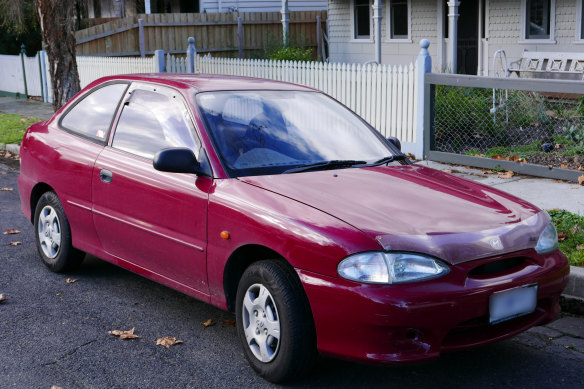
Among the mysteries of the cost-of-living crisis is people’s dogged determination to pay ever more for cars that are constantly getting bigger, faster and more complex. My personal solution in this desperately aspirational age was to get back to basics, in the form of a plain 1999 Hyundai Excel that I have grown to adore.
Its predecessor, with an exhaust carefully tuned to deliver an ego-boosting cacophony of snaps, crackles and pops, was another Hyundai, a so-called “hot hatch” that every motoring journalist raved about, but with way more capability than I ever knew what to do with, especially for the money.

A 1999 Hyundai Excel. It’s no Ferrari, but it gets the job done.Credit: Wikimedia Commons
Initially looking at newer, budget runabouts, the prices of which have since skyrocketed, I ended up trawling through online listings, starting with older models from overlooked brands and finding cheap, low-mileage examples.
The vehicle I stumbled upon one afternoon represented every cliche: little old lady, church on Sundays … you know the deal … and with a staggering 19,000 genuine kilometres on the clock. At $3500, it was a bargain. After some new tyres and a service, it was good to go.
Unicorn or not though, my family was appalled when this dumpy little darling, with all the charm of an upturned bathtub, pulled into our driveway. What would the neighbours think? Friends could barely hide their bewilderment – can’t he afford better? Their collective horror reached fever pitch when they looked inside to find … wind-up windows and … no screen.
Nevertheless, with its low mileage and the technology of a domestic lawn mower, it chugs along reliably, and very cheaply. Tyres cost $80 each instead of $320 for the high-tech Italian rubber on my previous Hyundai and a mechanic friend charges $150 for basic servicing. Since no insurance company will offer sufficient replacement valuation (most comparable versions are indeed old bombs), I only have third-party cover.
With the majority of my miles being in the bush, I’m also reassured that there’s a full-size spare wheel tucked away under the boot. Few people realise that many new cars only offer awkward tyre-repair kits or space-saver spares that are speed-limited to 80 kilometres an hour. Not much good for roadside repairs or keeping up with highway traffic. And I don’t have to worry about low-profile tyres and expensive alloy rims being destroyed by potholes.
But, for country usage, wouldn’t I be better off with a 4WD or SUV, like almost everyone else? Well perhaps, but it’s important to remember that few people owned such high-riding steeds 20 or 30 years ago, even those who enjoyed roughing it outdoors. In reality, a little care along corrugated country lanes goes a long way towards protecting the underside from more severe ruts. And when the mower at our weekender breaks down, there’s a surprising amount of space in the rear hatch.
On Aussie autobahns, it certainly doesn’t have serious overtaking muscle, but its power-to-weight ratio is comparable to contemporary city cars, so it’s more than enough. Perhaps the biggest menace is impatient motorists, the kind who manically dart in and out of traffic, profiling drivers based on what they are driving. They tailgate my plucky little mate while presuming that the previous elderly owner is still behind the wheel.



























